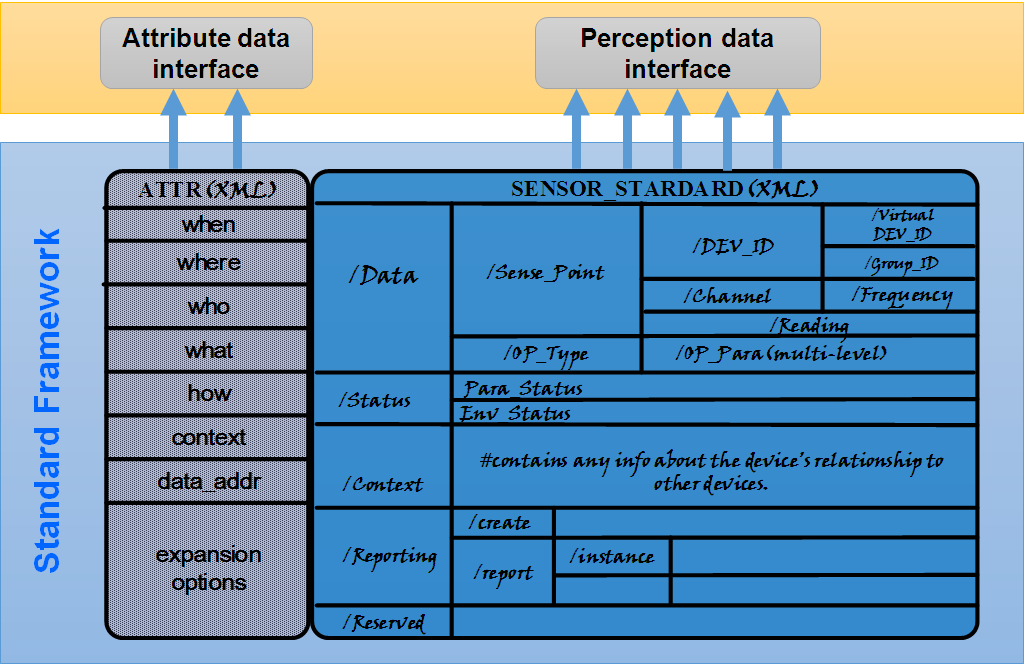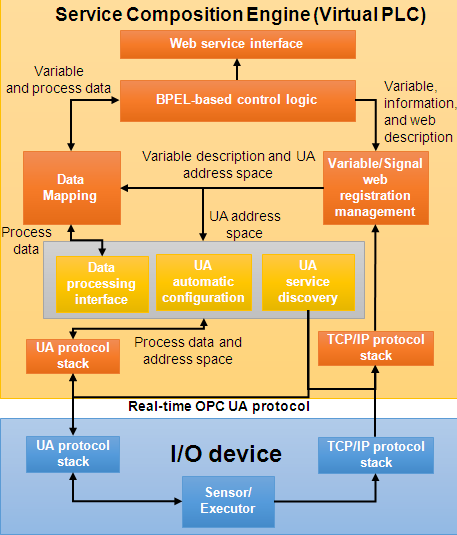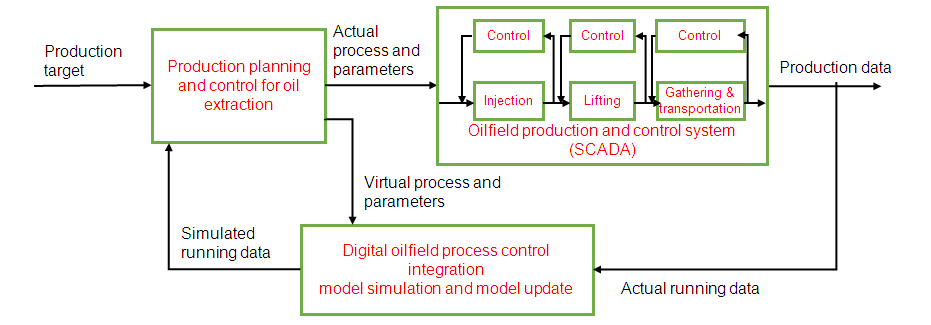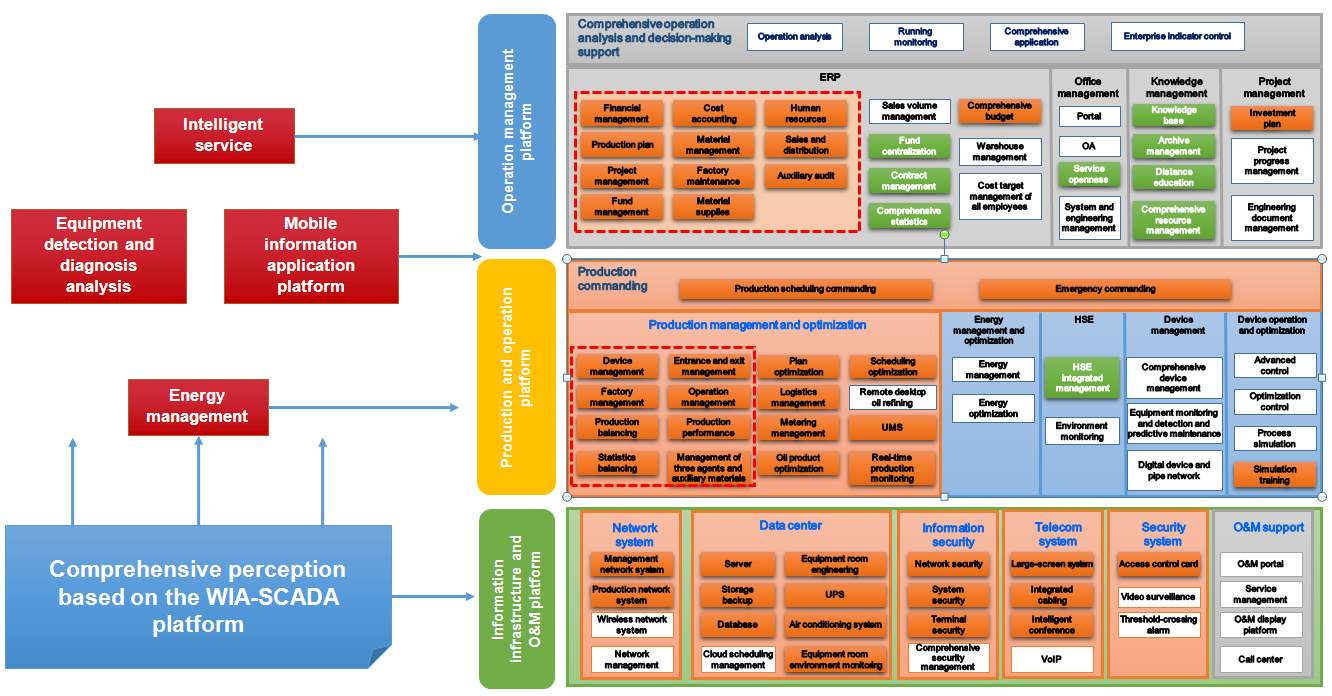- About Us
- News
- Results Released
- Application Scenarios
- Resource Center
- Meeting

Industrial IoT Verification and Demonstration Platform Focusing on the Petrochemical/Oilfield Industry
Shenyang Institute of Automation, Chinese Academy of Sciences
Petro-CyberWorks Information Technology Co., Ltd.
The Industrial IoT Verification and Demonstration Platform (hereinafter referred to as “the Platform”) aims to implement fast data collection and association modeling of the Internet of Things (IoT) devices through industrial IoT platforms. Based upon the overall industrial Internet framework defined by the oneM2M global standards initiative, the Platform focuses on middleware development with a cloud-based architecture to enable collection, receipt, integration, conversion, standardization, and intelligent transmission of mass IoT data. In addition, the Platform accurately determines on-site physical conditions, and enables other universal IoT platform products for petrochemical/oilfield enterprises. In this way, the middleware can be used as IoT access components of intelligent manufacturing platforms to deliver basic IoT access capabilities and ubiquitous awareness services, and also as independent products to provide services for enterprises. By analyzing factors such as energy and production consumption, production status difference, energy meter conditions, and major indicator trends at the network edge, the Platform helps enterprises detect energy weak points, find energy conservation points, and take targeted energy optimization measures to maximize energy efficiency.
To support a new interconnection production method with intelligent services, the industrial IoT platform system first aims to enable industrial measurement and control systems to precisely perceive and control operating conditions of devices. It also aims to expand interconnection and integration between industrial measurement and control systems with other systems such as Product Lifecycle Management (PLM), Enterprise Resource Planning (ERP), and Manufacturing Execution System (MES), in order to support End-to-End (E2E), full-lifecycle optimization. Based on the above objectives, the following core technologies are implemented:
●Large-scale, low-cost ubiquitous perception: The existing industrial measurement and control systems adopt fieldbus-based sensor networking technology, leading to high cabling and maintenance costs. As a result, those systems cannot meet the requirements for large-scale, low-cost perception and control of device operating conditions.
●E2E, full-lifecycle heterogeneous data integration: The existing industrial measurement and control systems use metadata-based real-time and historical data management technology. This technology makes it difficult to meet the convergence and interoperability requirements of structural and non-structural video, voice, text, and sensor data required for E2E, full-lifecycle optimization.
●Flexible programming of reconfigurable systems: The existing industrial measurement and control systems use IEC 61131 programming and I/O configuration. This standard makes it difficult to meet the flexible programming requirements of dynamic planning, scheduling, and control based on market prices and operating conditions required for E2E, full-lifecycle optimization.
The main research concepts for developing the Platform are as follows:
●Extend ubiquitous perception based on wireless sensor networks, and collect data synchronously with the fieldbus.
●Build a globally unified semantic model to achieve E2E, full-lifecycle heterogeneous data integration.
●Change the original hierarchical data integration architecture to a web service-based architecture; flatten automation systems; and build an action-oriented programming model based on service combinations to implement E2E, full-lifecycle flexible programming of industrial measurement and control applications.
Based upon these technical research concepts, the next-generation architecture of the M2M- and service-based industrial IoT platform system is constructed, as shown in Figure 4-1.
Figure 4-1 Main research concepts for the project to develop the industrial IoT platform architecture

The industrial IoT platform system offers the following features:
●Perception: The existing industrial measurement and control systems or Distribution Control Systems (DCSs) cannot monitor the operating conditions for a large number of production devices, energy flows, and logistics pipelines. To solve this issue, industrial IoT platforms use IoT technologies based on wireless sensor networks to expand traditional fieldbus technology, and implement large-scale, low-cost deployment and plug-and-play sensors. In addition, based on physical location features and monitoring requirements of production equipment groups, energy flows, and logistics pipelines, industrial IoT platforms use large-scale high-concurrency mesh and real-time chain networking technology.
●Data collection: Working together with the existing industrial measurement and control systems or DCSs, industrial IoT platforms use data collection technology to realize time synchronization with these systems. In addition, the platforms adopt level-crossing sampling and real-time compensation synchronization technologies for efficient transmission of mass wireless sensor data and synchronization between wireless sensor networks and the fieldbus.
●Data storage and management: Industrial measurement and control systems collect real-time operating data, while PLM, ERP, and MES systems manage information data. To meet the integrated data analysis requirements of these systems, industrial IoT platforms use semantic data integration technology to effectively integrate traditional historical and real-time databases. In addition, the unified semantic model with spatiotemporal-data semantic search technology is proposed for structural and non-structural data features of perception, control, and management.
●Monitoring application programming and configuration: Industrial IoT platforms use web-based service combination technology to replace traditional IEC 61131 programming and I/O configuration so that E2E, full-lifecycle optimization can be applied for PLM, ERP, and MES systems, industrial measurement and control systems, and DCSs. For action-oriented programming of industrial measurement and control systems, the platforms also provide programming technology based on complex event processing and dynamic service synthesis.
The components and functions of each subsystem are as follows:
1. M2M-based perception networking system and smart wireless meters
Real-time monitoring of production equipment groups, energy flows, and logistics pipeline working conditions is not supported by the existing industrial measurement and control systems or DCSs. To meet this requirement, the Platform implements large-scale high-concurrency mesh and real-time chain networking technology to eliminate concurrent conflicts and shorten multi-hop delays. Additionally, plug-and-play smart wireless meters can be connected to the Platform.
2. Semantic data integration software system
To meet the comprehensive analysis and application requirements of real-time operating conditions of data in industrial measurement and control systems and information management data for PLM, ERP, and MES systems, the Platform uses a unified semantic model with spatiotemporal-data semantic search technology. This helps integrate multiple-source heterogeneous perception data as well as cross-layer, cross-domain management, and control data. The Platform also introduces semantic ontology databases, domain knowledge libraries, and semantic search engines.
Figure 4-2 Semantic standardization framework for interconnection production data

3. Programming and service composition engine
The Platform uses action-oriented programming technology based on complex event processing and dynamic service synthesis to meet the requirements of PLM, ERP, and MES systems as well as industrial measurement and control systems and DCSs for E2E, full-lifecycle optimization of application programming. This technology helps achieve web-based encapsulation of real-time monitoring functions and real-time monitoring. The Platform also introduces a service composition engine, as shown in Figure 4-3.
Figure 4-3 Principles of service composition mechanism for device control logic

To meet the requirements of process and discrete manufacturing industries such as oilfield and petrochemical industries, the preliminary system solution can be developed based upon an innovative design which implements a new interconnection production method with intelligent services. The support technology system and products will help expand standard systems and solutions for intelligent manufacturing technologies in process industries that adapt to countries like China, whose current situation is to promote the digital transformation of enterprises.
Industrial IoT platforms are developed based on the Platform, and the following two new production models can be implemented:
1. Oilfield interconnection production innovation model based on real-time oil reserves analysis
Real-time acquisition of oilfield production information and real-time integration analysis and dynamic optimization of each process system must be achieved to realize the sustainable development of oilfields. Based on wireless networking and low power consumption data collection technologies, data collection, analysis, and optimization control of oilfield ground injection, lifting, and transmission systems are utilized to achieve closed-loop management of the ground production system. Based on real-time data from the ground production processes and the existing static data of oilfields, an integrated simulation of the digital oilfield process control based on the dynamic oil reserves model is implemented through automatic integration of multiple processes using software. This greatly simplifies analysis and shortens the time needed for oil reserves analysis. The parameter settings (such as the distribution of injection and recovery quantities) of the ground production system can be matched with the dynamic evolution of the underground oil reserves, and can be dynamically adjusted to achieve maximum production. This solution optimizes the digital oilfield production loop including faster analysis of underground oil reserves and the ground production system, as shown in the following figure.
Figure 6-1 New closed-loop oilfield production and operation model with dynamic optimization

The new optimized production method of oilfield injection and exploration based on real-time oil reserves analysis is designed to greatly improve overall production efficiency, automate equipment operations with less power consumption, lower equipment maintenance, and reduce maintenance costs.
In terms of edge computing, an oilfield wireless gateway directly calculates the indicator diagram at the network edge by collecting three-phase parameters and oil and casing pressure temperature data of an oil well, and then works with the pumping unit controller to provide a calculated indicator diagram model. This saves on transmission costs caused after the data is uploaded to a server for computing at a long distance. Additionally, closed-loop intelligent processing at the network edge can be implemented.
2. Online monitoring of production process parameters, and optimization management and control innovation model
Based on the existing information system, this innovation model implements centralized management, real-time monitoring, and comprehensive analysis of abundant production information through system integration and modeling. Currently, personnel at different layers monitor equipment data, manage and maintain equipment, and make plans and decisions using PCS, MES, and ERP systems. To improve upon the process, this innovation model integrates PCS, MES, and ERP systems through predictive maintenance and an intelligent service system of large production equipment. That is, the operation management layer, production operation layer, and process control layer are vertically integrated. Using Big Data analytics for comprehensive perception of equipment data, this model can predict some situations, accurately determine the causes of major machine unit faults, and pre-warn about key parts in advance. In this way, spare parts procurement, preventive maintenance, and intelligent services can be properly arranged. This effectively reduces Operations and Maintenance (O&M) costs and prevents losses caused by unplanned downtime, achieving optimal integrated and intelligent production equipment management and control.
Figure 6-2 Application model

The innovation model demonstration system includes energy management, equipment monitoring and diagnosis analysis, and mobile information platforms. The system performs centralized management, real-time monitoring, and intelligent analysis on various enterprise production information. It becomes a collaborative work platform for enterprise production and operations, comprehensive scheduling, and emergency commanding, and provides informatization support for routine scheduling of meetings within enterprises.
In terms of edge computing, a petrochemical wireless gateway collects on-site temperature and pressure data, detects device and equipment information, and reports alarms for device status monitoring, basic metering, and variable thresholds. This saves on transmission costs of alarm application logic after data is uploaded to a server. In addition, intelligent processing can be implemented at the network edge.
In terms of technological progress, industrial IoT platforms converge Information Technologies (IT) and Operational Technologies (OT), and comprehensively upgrade traditional industrial measurement and control systems, based on advanced integration in both the IoT and semantic web technologies. Specifically, the following aspects are achieved from the new system infrastructure:
1. The Platform establishes a technical architecture for industrial IoT systems built upon web-based open application services. This improves automation of industrial measurement and control systems with more accurate detection and control of the operating conditions of devices by integrating with wireless sensor networks. Further, this expands the interconnection and degree of integration between industrial measurement and control systems with PLM, ERP, and MES systems through semantic web service integration to provide E2E, full-lifecycle system optimization.
2. The Platform delivers new technical solutions for integration between traditional industrial automation systems and the Internet, which will promote the development of industrial IoT technologies.
3. The Platform creates a business model for interconnection production and intelligent services to improve other process industries, builds a new application system to automate and streamline production of petroleum and petrochemical industries, and provides a new technical system that can be integrated to advance the development of smart factories.
Application projects based on the Platform have been widely implemented for petroleum, power grids, and petrochemical industries, helping to increase profits, reduce costs, automate IoT technologies, offer more intelligent application services, and bring more economic benefits.
In the aspect of social development, China has proposed the national development strategy “Made in China 2025” while, from a global perspective, other countries draw inspiration from “Industry 4.0”. The goal of this strategic initiative targets China’s manufacturing enterprises to be upgraded by 2025 and achieve the national goal as a global leader in the manufacturing sector. Industrial IoT platforms will provide comprehensive tools to support technical infrastructures for China’s manufacturing upgrades, and will help to expand development of intelligent manufacturing solutions that fulfill the national conditions. As a result, industrial IoT platforms are of great significance to promote energy savings and emission reduction, improve efficiency, and upgrade the production methodologies across China’s process industries.